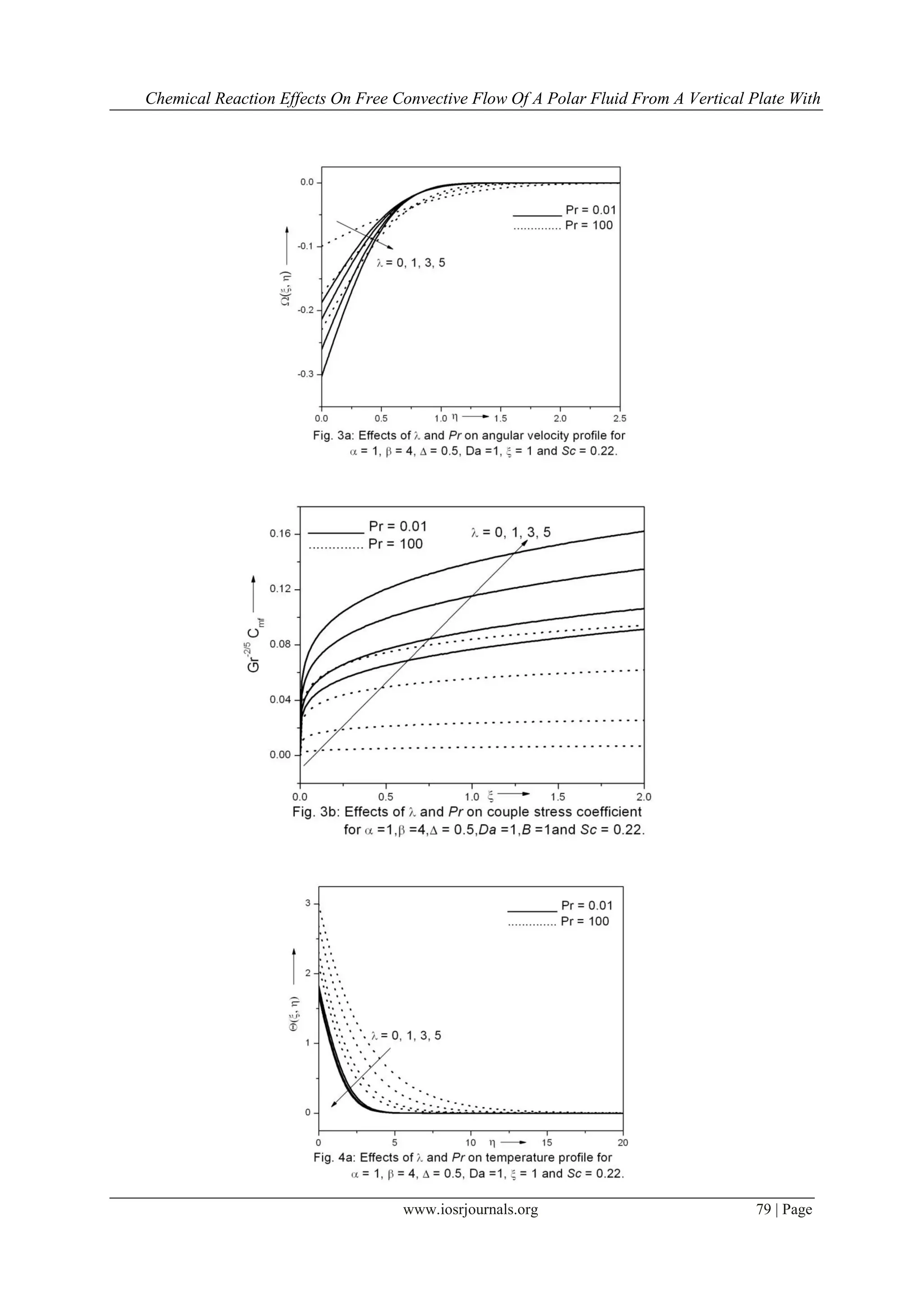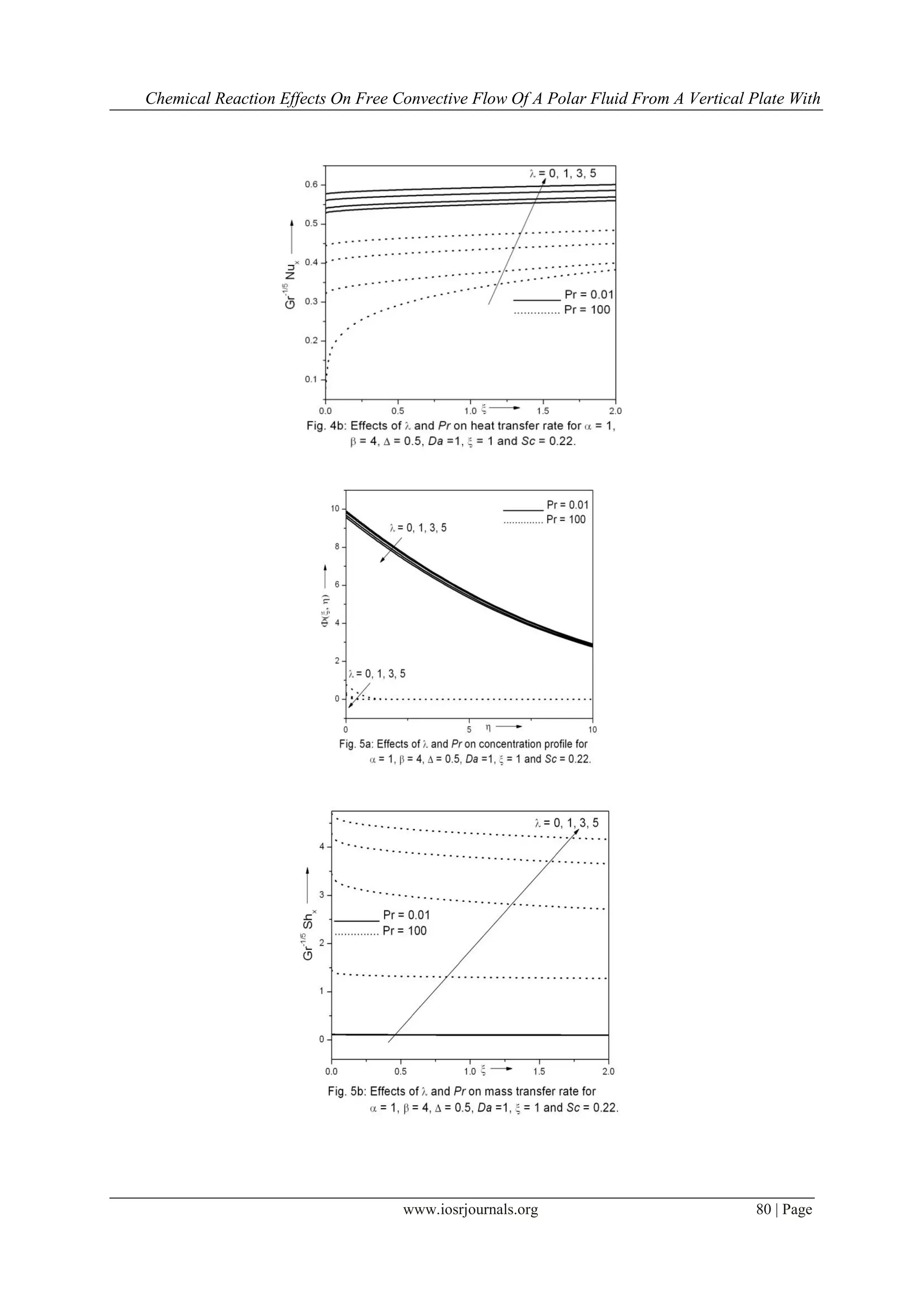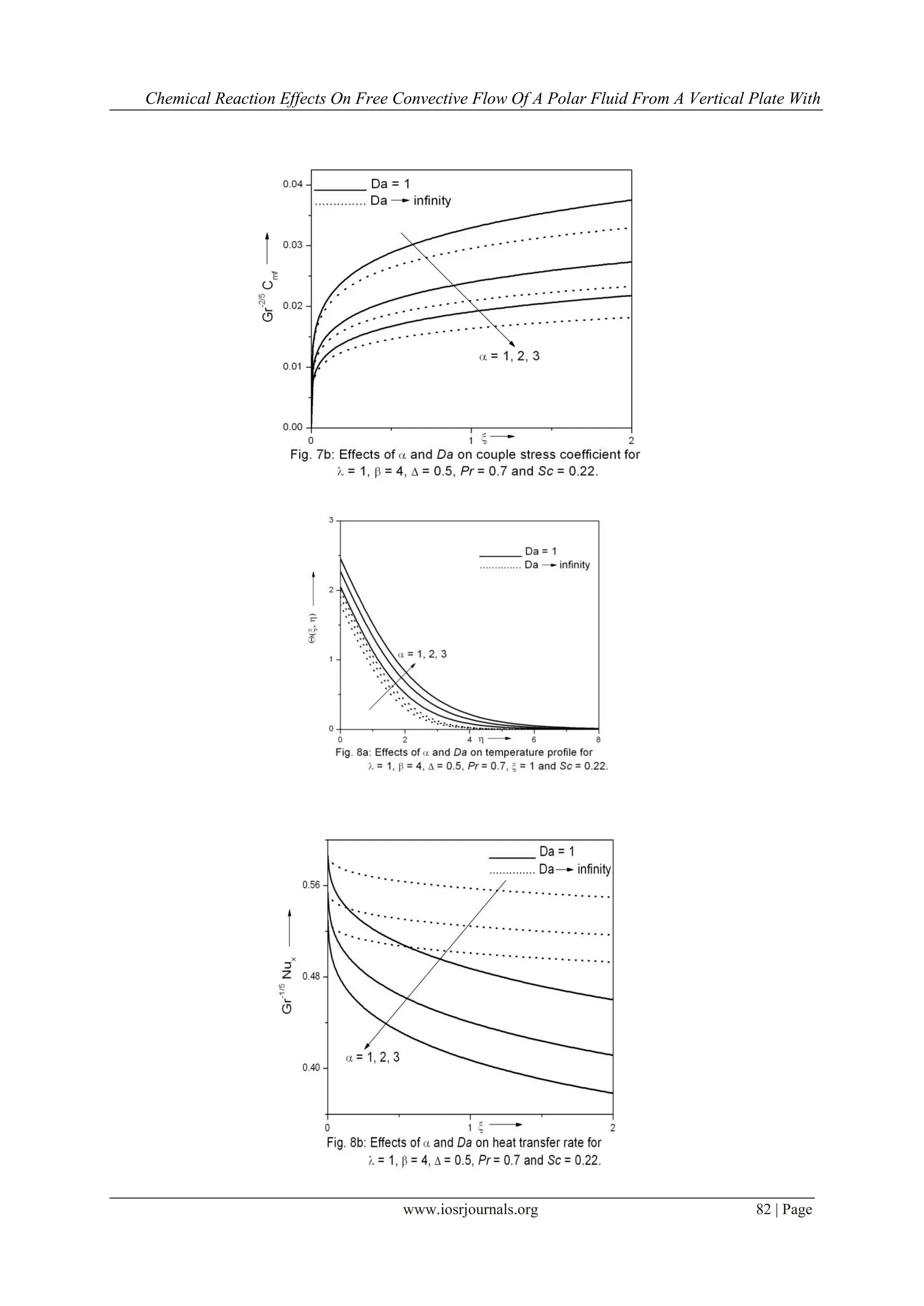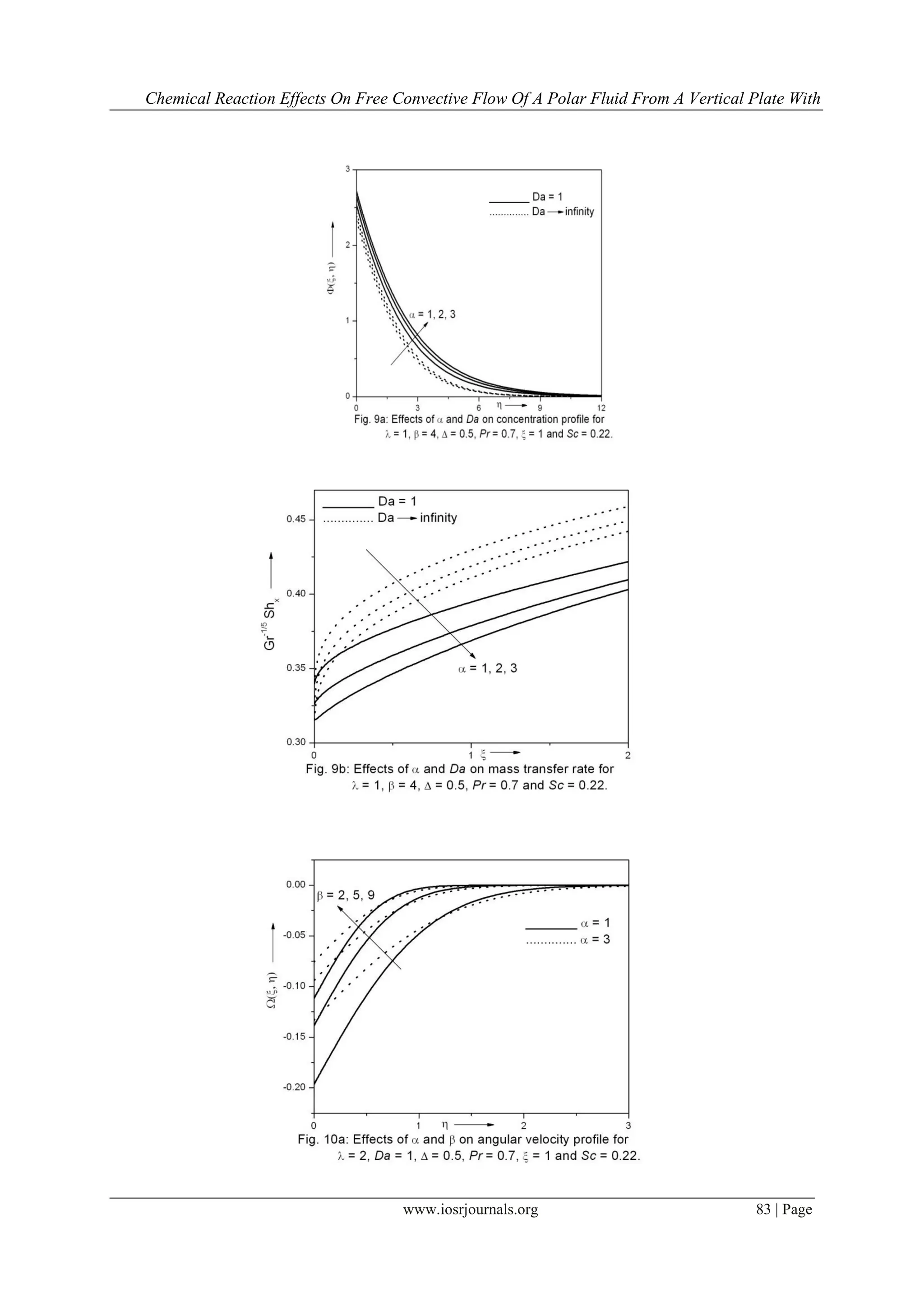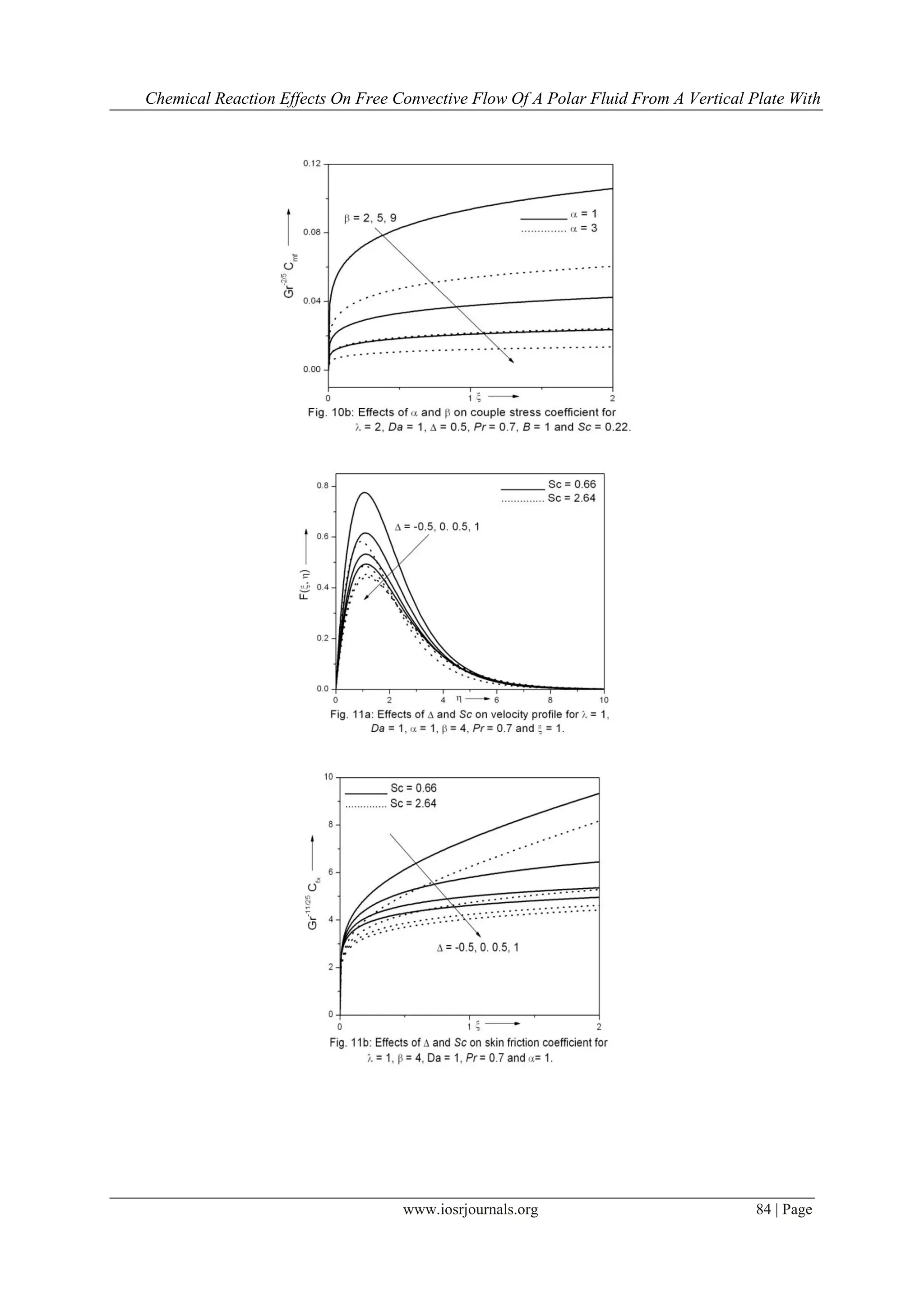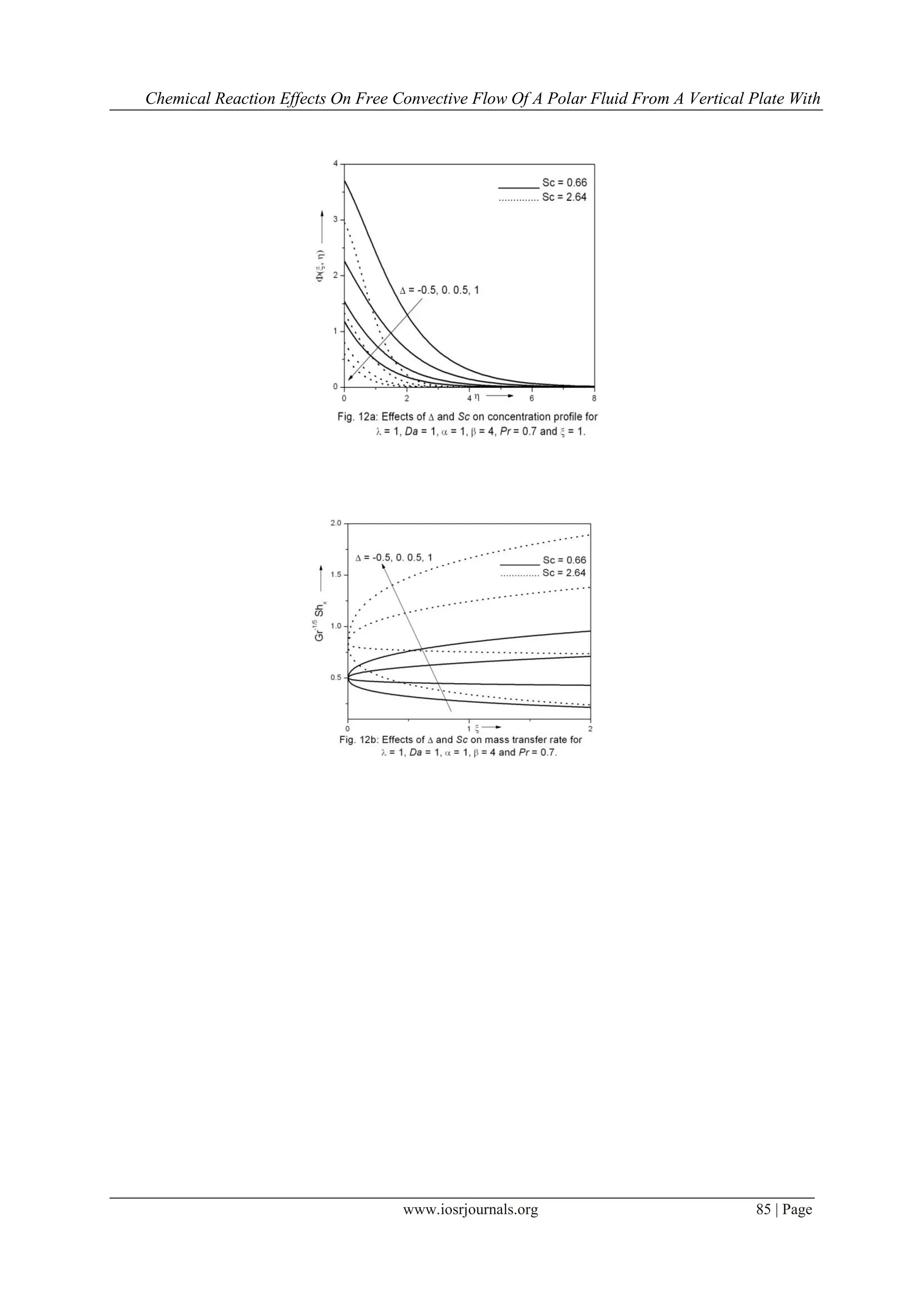This study investigates the two-dimensional free convective flow of a polar fluid through a porous medium affected by thermal and mass diffusion in the presence of a first-order chemical reaction. Governing equations are transformed into a system of non-similar equations and solved numerically, revealing significant influence of polar effects on flow characteristics. The results align well with previously published work, showcasing the effects of mass and thermal diffusion along with couple stresses on the flow field.
![IOSR Journal of Mathematics (IOSR-JM)
e-ISSN: 2278-5728,p-ISSN: 2319-765X, Volume 6, Issue 5 (May. - Jun. 2013), PP 66-85
www.iosrjournals.org
www.iosrjournals.org 66 | Page
Chemical Reaction Effects on Free Convective Flow of a Polar
Fluid from a Vertical Plate with Uniform Heat and Mass Fluxes
P. M. Patil
Department of Mathematics, J S S’s Banashankari Arts, Commerce and Shanti Kumar Gubbi Science College,
Vidyagiri, Dharwad – 580004, Karnataka, India.
Abstract: This article deals with a study of two dimensional free convective flow of a polar fluid through a
porous medium due to combined effects of thermal and mass diffusion in presence of a chemical reaction of first
order. The objective of the present investigation is to analyze the free convective flow in the presence of
prescribed wall heat flux and mass flux condition. The governing partial differential equations are non-
dimensionalized and transformed into a system of non-similar equations. The resulting coupled nonlinear
partial differential equations are solved numerically under appropriate transformed boundary conditions using
an implicit finite difference scheme in combination with quasilinearisation technique. Computations are
performed for a wide range of values of the various governing flow parameters of the velocity, angular velocity,
temperature and species concentration profiles and results are presented graphically. The numerical results for
local skin friction coefficient, couple stress coefficient, local Nusselt number and local Sherwood number are
also presented. The obtained results are compared with previously published work and were to be in excellent
agreement. The study reveals that the flow characteristics are profoundly influenced by the polar effects.
Keywords: Free convection; polar fluid; porous medium; chemical reaction; quasilinearisation.
I. Introduction
The flow through a porous medium under the influence of temperature and concentration differences, is
one of the most important and contemporary subjects, because it finds great applications in geothermy,
geophysics and technology. The practical interest in convective heat and mass transfer through a porous medium
has grown rapidly due to the wide range of applications in engineering fields. These important applications
include such areas as geothermal energy utilization, thermal energy storage and recoverable systems, petroleum
reservoirs, insulation of high temperature gas-solid reaction vessels, chemical catalytic convectors, storage of
grain, fruits and vegetables, pollutant dispersion in aquifers, agricultural and water distribution, buried electrical
cables, combustion in situ in underground reservoirs for the enhancement of oil recovery, ceramic radiant
porous burners used in industrial firms as efficient heat and mass transfer devices and the reduction of hazardous
combustion products using catalytic porous beds. An excellent review on this subject can be found in the review
article by Cheng [1]. Lee et al. [2] examined the effects of mixed convection along vertical cylinders and
needles with uniform surface heat flux using a single curvature parameter as well as single buoyancy parameter
to treat the limiting case of natural convection along the surface.
Non-Newtonian fluids in porous media exhibit a non-linear flow behavior that is different from that of
Newtonian fluids in porous media. The research on heat and mass transfer in flows of non-Newtonian fluids in
porous media is very important due to its practical applications in engineering, such as oil recovery, food
processing, the spreading of contaminants in the environment and in various processes in the chemical and
materials industry. Chen and Chen [3] presented similarity solutions for natural convection of a non-Newtonian
fluid over vertical surfaces in porous media. Nakayama and Koyama [4] studied the natural convection of a non-
Newtonian fluid over non-isothermal body of arbitrary shape in a porous medium. Kim and Hyun [5] examined
natural convection flow of power-law fluid in an enclosure filled with heat generating porous media. Rastogi
and Poulikakos [6] studied double diffusion from a vertical surface embedded in a porous medium saturated
with a non-Newtonian fluid. These authors have found that the variation of the wall temperature and
concentration necessary to yield a constant heat and mass flux at the wall depended strongly on the power law
index. Jumah and Majumdar [7, 8] analyzed heat and mass transfer in free convection flow of non-Newtonian
power law fluids with yield stress over a vertical plate in saturated porous media subjected to constant/variable
wall temperature and concentration. Recently, Cheng [9] studied heat and mass transfer in natural convection of
non-Newtonian power law fluids with yield stress in porous media from a vertical plate with variable wall heat
and mass fluxes.
Another important class of fluids, called polar fluids, which is a special family of non-Newtonian
fluids, whose constitutive equations were developed by Aero et al. [10] and D’ep [11], exhibits boundary layer
phenomenon. In the literature, polar fluids are characterized as those fluids with micro-structures, which are
mechanically significant when the characteristic dimension of the problem is of the same order of magnitude as](https://image.slidesharecdn.com/h0656685-150428024736-conversion-gate02/75/Chemical-Reaction-Effects-on-Free-Convective-Flow-of-a-Polar-Fluid-from-a-Vertical-Plate-with-Uniform-Heat-and-Mass-Fluxes-1-2048.jpg)
![Chemical Reaction Effects On Free Convective Flow Of A Polar Fluid From A Vertical Plate With
www.iosrjournals.org 67 | Page
the size of the micro-structure. Extensive reviews of the theory can be found in the review article by Cowin [12].
Since the micro-structure size is the same as the average pore size, it is pertinent to study the flow of polar fluids
through a porous medium. The examples of fluids which can be modeled as polar fluids are mud, crude oil,
body fluids, lubricants with polymer additives, etc. The effects of couple stresses on the flow of polar fluids
through a porous medium are studied by Patil and Hiremath [13]. Hiremath and Patil [14] examined the effects
of free convection on the oscillatory flow of a couple stress fluids through a porous medium. Effects of MHD on
unsteady free convection flow past a vertical porous plate was investigated by Helmy [15]. Steady flow of a
polar fluid through a porous medium by using Forchheimer’s model was discussed by Raptis and Takhar [16].
Kim [17] analysed the unsteady MHD convection flow of polar fluids past a vertical moving porous plate in a
porous medium. Analytical solutions for the problem of the flow of a polar fluid past a vertical porous plate in
the presence of couple stresses and radiation, where the temperature of the plate is assumed to oscillate about a
mean value are obtained by Ogulu [18]. Patil and Kulkarni [19] examined the effects of chemical reaction on
free convective flow of a polar fluid through a porous medium in the presence of internal heat generation.
Recently, Patil [20] analysed the effects of free convection on the oscillatory flow of a polar fluid through a
porous medium in the presence of variable wall heat flux. Free convective oscillatory flow of a polar fluid
through a porous medium in the presence of oscillating suction and temperature was examined by Patil and
Kulkarni [21]. Chang and Lee [22] examined the flow and heat transfer characteristics of the free convection on
a vertical plate with uniform and constant heat flux in a thermally stratified micropolar fluid.
The study of chemically-reactive flows with heat and mass transfer is also of fundamental interest in
engineering science research [23]. Levenspiel [24] provided an excellent discussion of such flows in the context
of chemical processes and batch reactor systems. Such flows are also important in cooling tower design,
geochemical transport in repositories and the dynamics of fog and mist composition, drying, distribution of
temperature and moisture over agricultural fields and groves of fruit trees, damage of crops due to freezing,
evaporation at the surface of a water body. Chemical reaction can be modeled as either homogeneous or
heterogeneous processes. This depends on whether they occur at an interface or a single phase volume reaction.
A homogeneous reaction is one that occurs uniformly throughout a given phase. On the other hand,
heterogeneous reaction takes place in a restricted area or within the boundary of a phase. The order of the
chemical reaction depends on several factors. One of the simplest chemical reactions is the first-order reaction in
which the rate of reaction is directly proportional to the species concentration. Fairbanks and Wilks [25] were
among the first researchers to use a homogeneous chemical reaction model in their study of isothermal diffusive
flow past a soluble surface. Van Genuchten [26] presented a theoretical model for adsorping and decaying
chemically-reactive mass transfer. Das et al. [27] studied the effects of mass transfer on the flow started
impulsively past an infinite vertical plate in the presence of wall heat flux and chemical reaction.
Muthucumaraswamy and Ganeshan [28, 29] studied the impulsive motion of a vertical plate with heat flux/
mass flux/ suction and diffusion of chemically reactive species. Seddeek [30] employed the finite element
method for studying the effects of chemical reaction, variable viscosity, thermophoresis, and heat
generation/absorption on a boundary layer hydromagnetic flow with heat and mass transfer over a heated
surface. Kandasamy et al. [31] examined the effects of chemical reaction on flow, heat and mass transfer with
heat source and suction. Kandasamy et al. [32] also examined the chemical reaction effects on
Magnetohydrodynamics flow, heat and mass transfer with heat source and suction. Raptis and Perdikis [33]
examined the effects of viscous flow over a non-linearly stretching sheet in the presence of chemical reaction
and magnetic field.
The aim of the present study is to investigate the effects of chemical reaction on natural convection
flow, with heat and mass transfer, of a polar fluid through a porous medium in the presence of couple stresses
and uniform wall heat and mass fluxes. The flow configuration is modeled as a vertical plate bounding the
porous region filled with fluid containing soluble and insoluble chemical materials. The fluid is modeled as a
polar fluid. The system of nonlinear coupled partial differential equations governing the flow is non-
dimensionalized and transformed into a system of non-similar, coupled nonlinear partial differential equations.
The resulting coupled nonlinear equations are solved numerically under appropriate transformed boundary
conditions using an implicit finite-difference scheme in combination with a quasi-linearization technique
Inouye and Tate [34] and Patil and Roy [35]. The obtained results are compared with some results reported by
Lee et al. [2] and Chang and Lee [22] and are found to be in excellent agreement. The study reveals that the
flow field is considerably influenced by the combined effects of mass and thermal diffusion in presence of
chemical reaction and couple stresses.
II. Mathematical Formulation
We consider steady, laminar, two-dimensional natural convection flow of a viscous incompressible
polar fluid over a semi-infinite vertical plate embedded in a porous medium. The x-coordinate is measured from
the leading edge of the vertical plate and the y-coordinate is measured normal to the plate. The velocity, angular](https://image.slidesharecdn.com/h0656685-150428024736-conversion-gate02/75/Chemical-Reaction-Effects-on-Free-Convective-Flow-of-a-Polar-Fluid-from-a-Vertical-Plate-with-Uniform-Heat-and-Mass-Fluxes-2-2048.jpg)
![Chemical Reaction Effects On Free Convective Flow Of A Polar Fluid From A Vertical Plate With
www.iosrjournals.org 68 | Page
velocity, temperature and concentration fields are , ,0u v , 0,0, , T and C, respectively. Figure 1 shows
the coordinate system and physical model for the flow configuration. The surface is maintained at uniform heat
flux wq as well as uniform mass flux wm . The concentration of diffusing species is assumed to be very small in
comparison with other chemical species far from the surface C , and is infinitely small. Hence, the Soret and
Dufour effects are neglected. However, the first-order homogeneous chemical reaction is assumed to take place
in the flow. All thermo-physical properties of the fluid in the flow model are assumed to be constant except the
density variations causing the buoyancy force represented by the body force term in the momentum equation.
The Boussinesq approximation is invoked for the fluid properties to relate density changes to temperature and
concentration changes, and to couple in this way the temperature and concentration fields to the flow field
(Schlichting [36]). Under the above assumptions, the equations of conservation of mass, momentum, angular
momentum, energy and concentration governing the free convection boundary layer flow through porous
medium are given by (Aero et al. [10], D’ep [11], Patil [20] and Patil and Kulkarni [19, 21]):
0,
u v
x y
(1)
2
2
2 ,r
r r T C
u u u
u v g T T C C u
x y y y K
(2)
2
2
,u v
x y I y
(3)
2
2
P
T T k T
u v
x y C y
(4)
2
12
,
C C C
u v D k C C
x y y
(5)
where 1
a dC C I
. All of the parameters appearing in Eqs. (1)- (5) are defined in the Nomenclature
section.
The appropriate boundary conditions are:
2
,2
0 : 0, 0, , ,w w
u T C
y u v m k q D m
y y y y
: 0, 0, , .y u T T C C (6)
The boundary conditions (6) are derived on the basis of the assumption that the couple stresses are dominant
during the rotation of the particles. Further, m is a constant and 0 1m . The case m = 0, which corresponds
to 0
y
at the wall represents concentrated particle flows in which the micro elements close to the wall
surface are not able to rotate. This case is known as strong concentration of micro elements. The case m = 0.5,
which corresponds to the vanishing of antisymmetric part of the stress tensor and indicates weak concentration
of micro elements. The case m = 1.0, which corresponds to the modeling of turbulent boundary layer flows.
Here, we shall consider the case of m = 0.5.](https://image.slidesharecdn.com/h0656685-150428024736-conversion-gate02/75/Chemical-Reaction-Effects-on-Free-Convective-Flow-of-a-Polar-Fluid-from-a-Vertical-Plate-with-Uniform-Heat-and-Mass-Fluxes-3-2048.jpg)

![Chemical Reaction Effects On Free Convective Flow Of A Polar Fluid From A Vertical Plate With
www.iosrjournals.org 70 | Page
0
f
,
3
3
1
2
f
, 1
, 1
at 0 ,
0
f
, 0 , 0 , 0 as . (13)
The quantities of physical interest, namely, the skin-friction coefficient, wall couple stress coefficient, local
Nusselt number and the local Sherwood number are defined, respectively, as
11/25 1/5
2
2
2 1 ,0r
fx
u
C Gr f
U y
,
i.e.
11/25
fxC Gr
= 1/5
2 1 ,0f . (14)
2/5 1/5
,0mf
B
C Gr
I U L y
,
i.e. 2/5 1/5
,0mf
B
C Gr
. (15)
x
h L
Nu
k
,
1/5 1
. .
,0
xi e Nu Gr
. (16)
and
x
hm L
Sh
D
,
1/5 1
. .
,0
xi e Sh Gr
. (17)
Where
2/5 3/5
Gr
U
L
and 2
B
L
.
III. Numerical Procedure
The set of non-dimensional equations (9)–(12) under the boundary conditions (13) for uniform wall
heat flux as well as uniform mass flux with the initial conditions obtained from the corresponding steady state
equations have been solved numerically using an implicit finite-difference scheme in combination with the
quasi-linearization technique by Inouye and Tate [34] and Patil and Roy [35].
Denoting, , ,f F , where
0
, ,f F d
, (18)
then Eqs. (9) – (12) take the form:
2/5
24 3 2 1
5 1 5 1 1 1
1
F f F F F
Da
FF f F
, (19)
4 2
5 5
f F F f , (20)
4 1
Pr Pr Pr
5 5
f F F f , (21)
2/54 1
5 5
Sc f Sc F Sc Sc F f , (22)
and the boundary conditions (13) reduce to:](https://image.slidesharecdn.com/h0656685-150428024736-conversion-gate02/75/Chemical-Reaction-Effects-on-Free-Convective-Flow-of-a-Polar-Fluid-from-a-Vertical-Plate-with-Uniform-Heat-and-Mass-Fluxes-5-2048.jpg)
![Chemical Reaction Effects On Free Convective Flow Of A Polar Fluid From A Vertical Plate With
www.iosrjournals.org 71 | Page
0 : 0F ,
1
2
F , 1 , 1 ,
: 0F , 0 , 0 , 0 . (23)
An iterative sequence of linear equations is carefully constructed to approximate the nonlinear
equations (19)–(22) under the boundary conditions (23) achieving quadratic convergence and monotonicity.
Applying the quasi-linearization technique, the nonlinear coupled ordinary differential equations (19)–(22) with
boundary conditions (23) yield the following sequence of linear ordinary differential equations:
1 1 1 1 1 1 1
1 2 3 4 5 6 7
i i i i i i ii i i i i i i
F A F A F A A A A A
, (24)
1 1 1 1 1
1 2 3 4 5
i i i i ii i i i i
B B B B F B
, (25)
1 1 1 1 1
1 2 3 4 5
i i i i ii i i i i
C C C C F C
, (26)
1 1 1 1 1
1 2 3 4 5
i i i i ii i i i i
D D D D F D
, (27)
where,
1
1 4
1 5
i
A f f
,
2/5
2
6
5 1 1
i F
A F
Da
,
3
1
i
A F
,
4
2
1
i
A
,
5
1
1
i
A
,
6
1
i
A
,
7
1 3
1 5
i
A F F
, 1
4
5
i
B f f
,
2
2
5
i
B F , 3
i
B F , 4
2
5
i
B
, 5 4
i i
B B F , 1
4
Pr
5
i
C f f
,
2
1
Pr
5
i
C F , 3 Pri
C F , 4
1
Pr
5
i
C
, 5
1
Pr
5
i
C F
,
1
4
5
i
D Sc f f
,
2/5
2
5
i F
D Sc
, 3
i
D Sc F , 4
5
i
D Sc
,
5
5
i
D Sc F
.
The coefficient functions with iterative index i are known and the functions with iterative index (i + 1)
are to be determined. The boundary conditions are given by
1
0
i
F
,
1 11
2
i i
F
,
1 1
1
i i
at 0 ,
1
0
i
F
,
1
0
i
,
1 1
0
i i
, as . (28)
where is the edge of the boundary layer.
Since the method is explained by Inouye and Tate [34] and also in a recent paper by Patil and Roy [35],
its detailed analysis is not presented here for the sake of brevity. In brief, the nonlinear coupled ordinary
differential equations were replaced by an iterative sequence of linear equations following quasi-linearization
technique. The resulting sequences of linear ordinary differential equations were expressed in difference form
using central difference scheme in - direction. In each iteration step, the equations were then reduced to a
system of linear algebraic equations with a block tri-diagonal structure which is solved by using Varga
algorithm [37].
To ensure the convergence of the numerical solution to the exact physical solution, the step size
and the edge of the boundary layer have been optimized and the results presented here are independent of the
step size at least up to the fifth decimal place. The step size of has been taken as 0.01. A convergence
criterion based on the relative difference between the current and previous iteration values is employed. When
the value of this difference reaches less than
5
10
, the solution is assumed to have converged and the iterative
process is terminated. Accuracy of the presented approach is verified by direct comparison with the results
previously reported by Lee et al. [2] and Chang and Lee [22] for a free convective flow of a Newtonian fluid](https://image.slidesharecdn.com/h0656685-150428024736-conversion-gate02/75/Chemical-Reaction-Effects-on-Free-Convective-Flow-of-a-Polar-Fluid-from-a-Vertical-Plate-with-Uniform-Heat-and-Mass-Fluxes-6-2048.jpg)
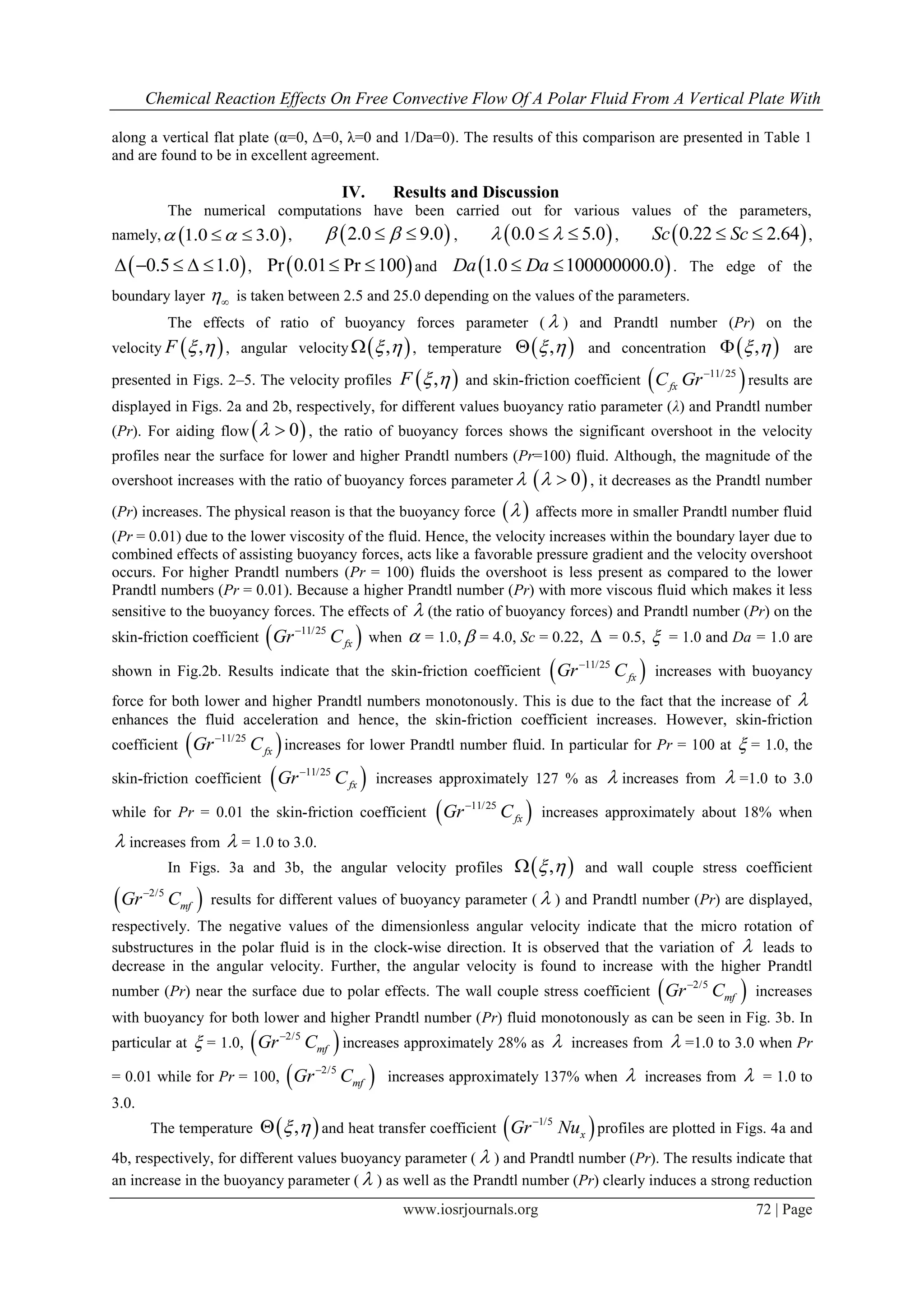
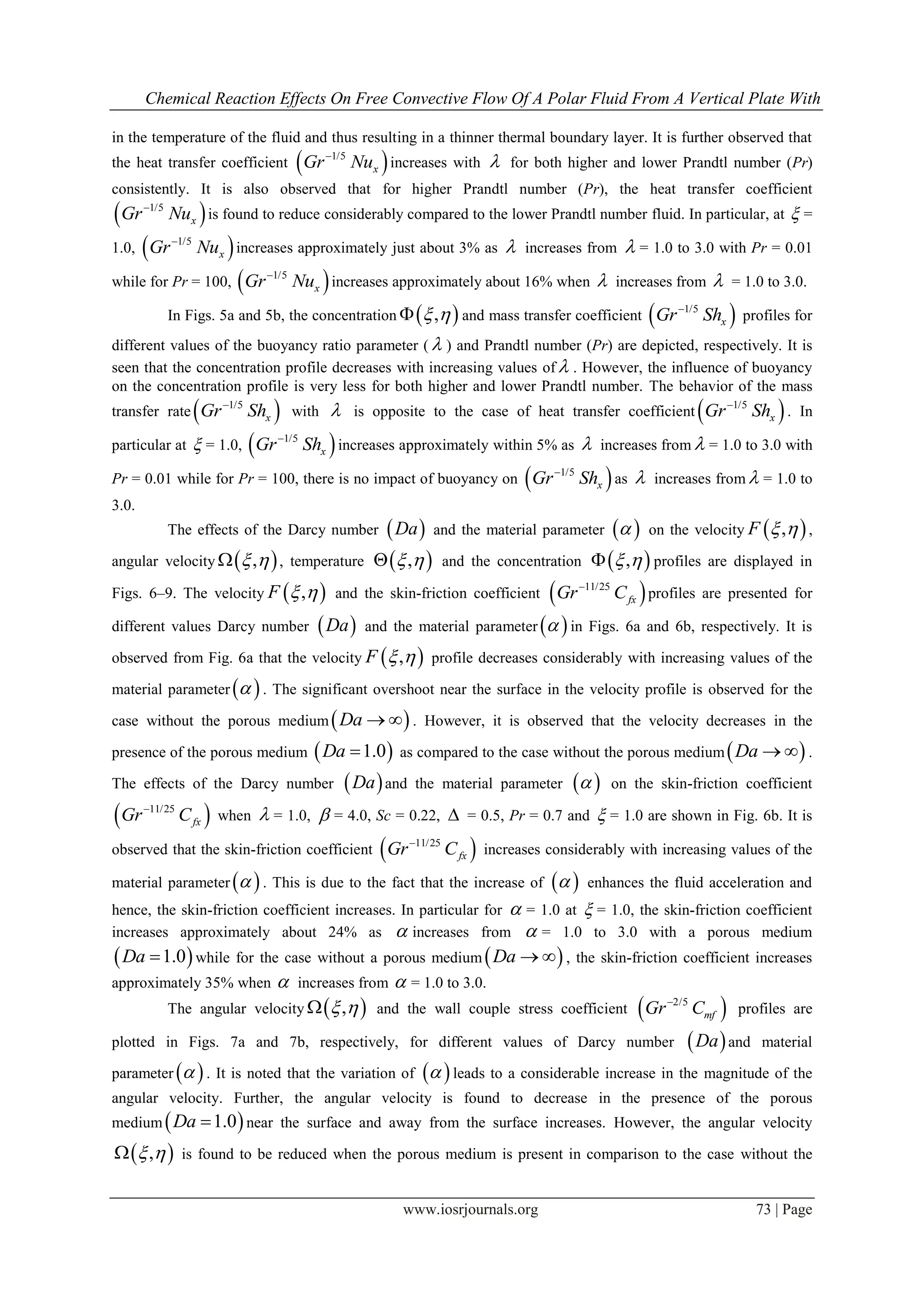
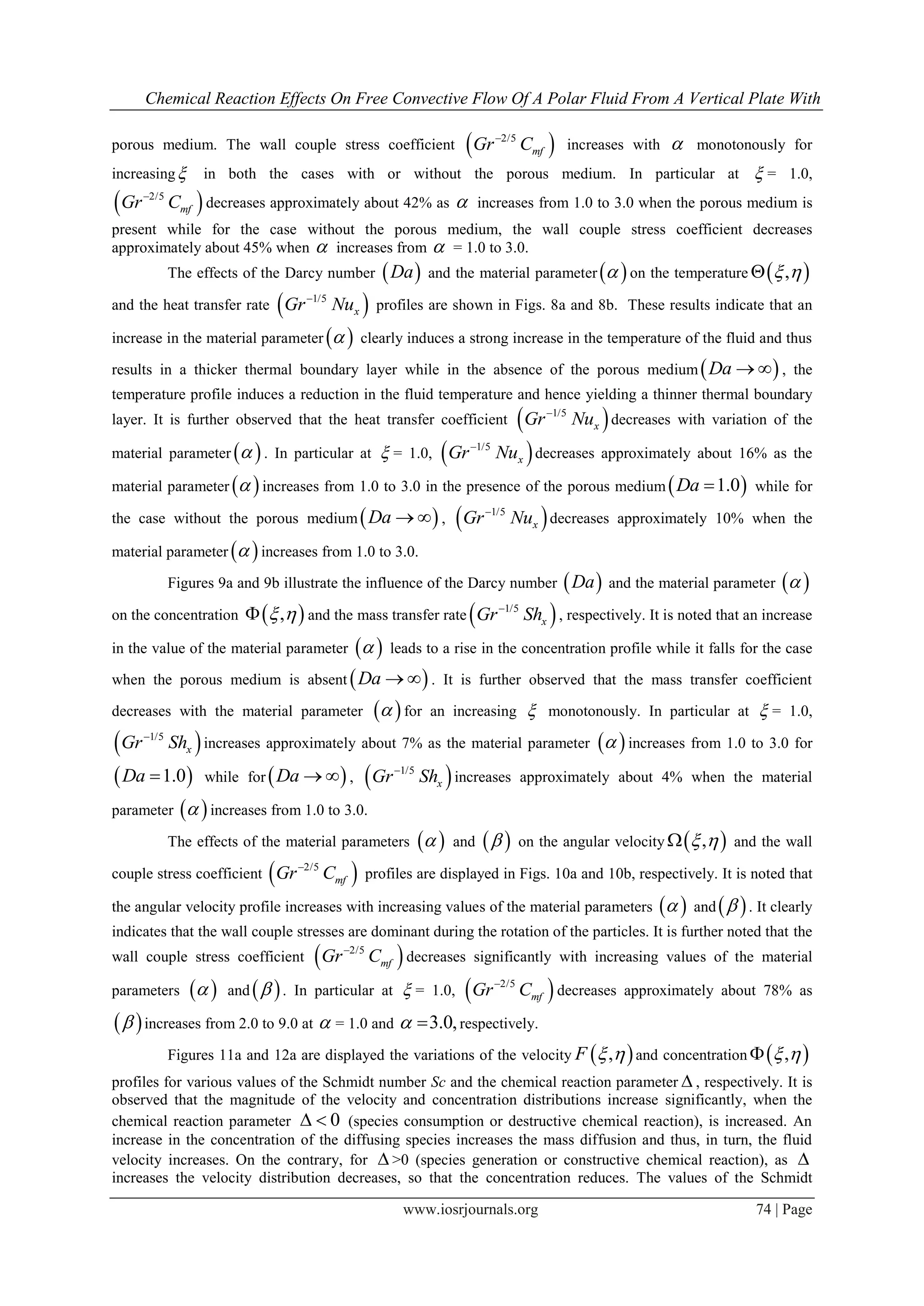
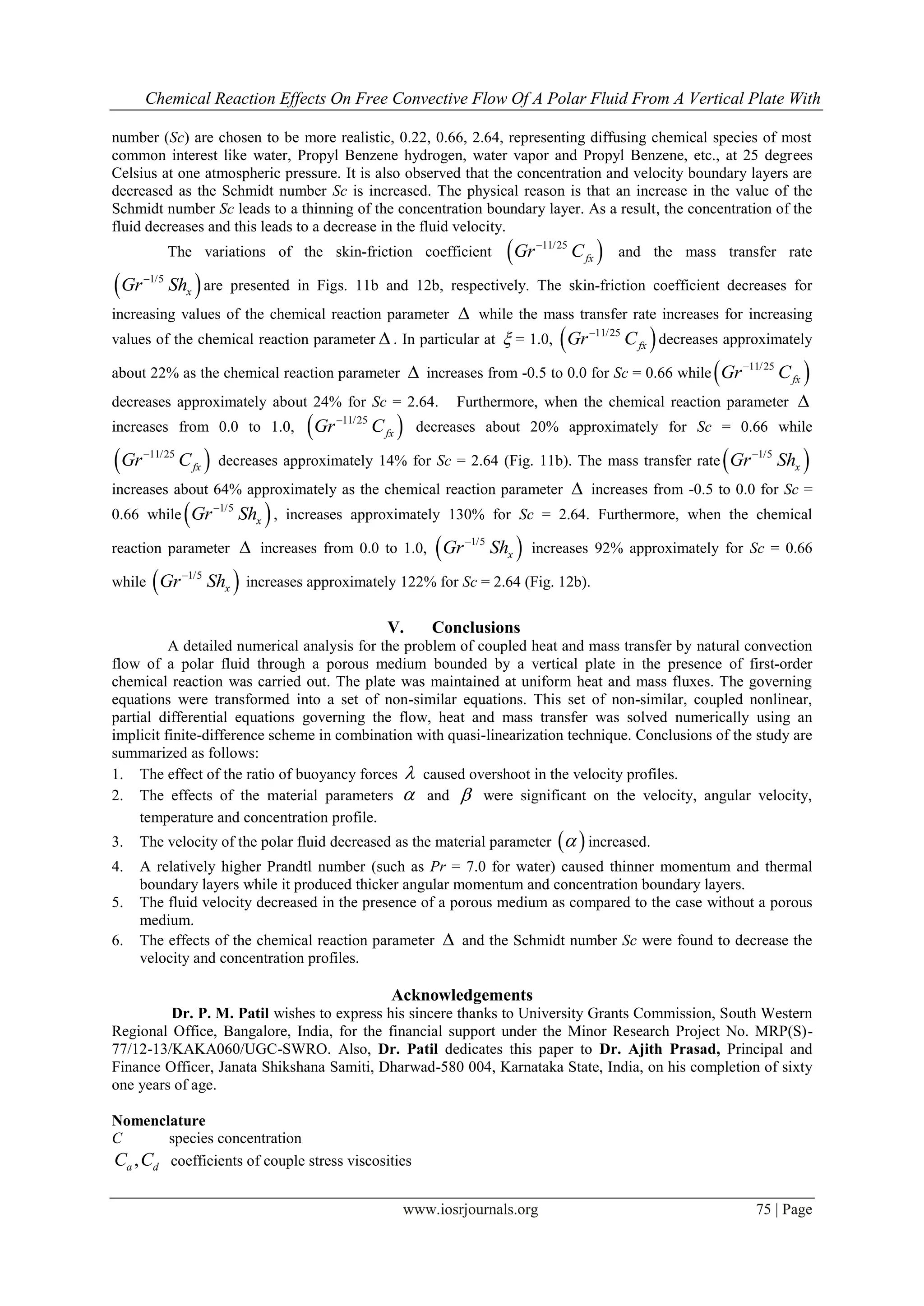
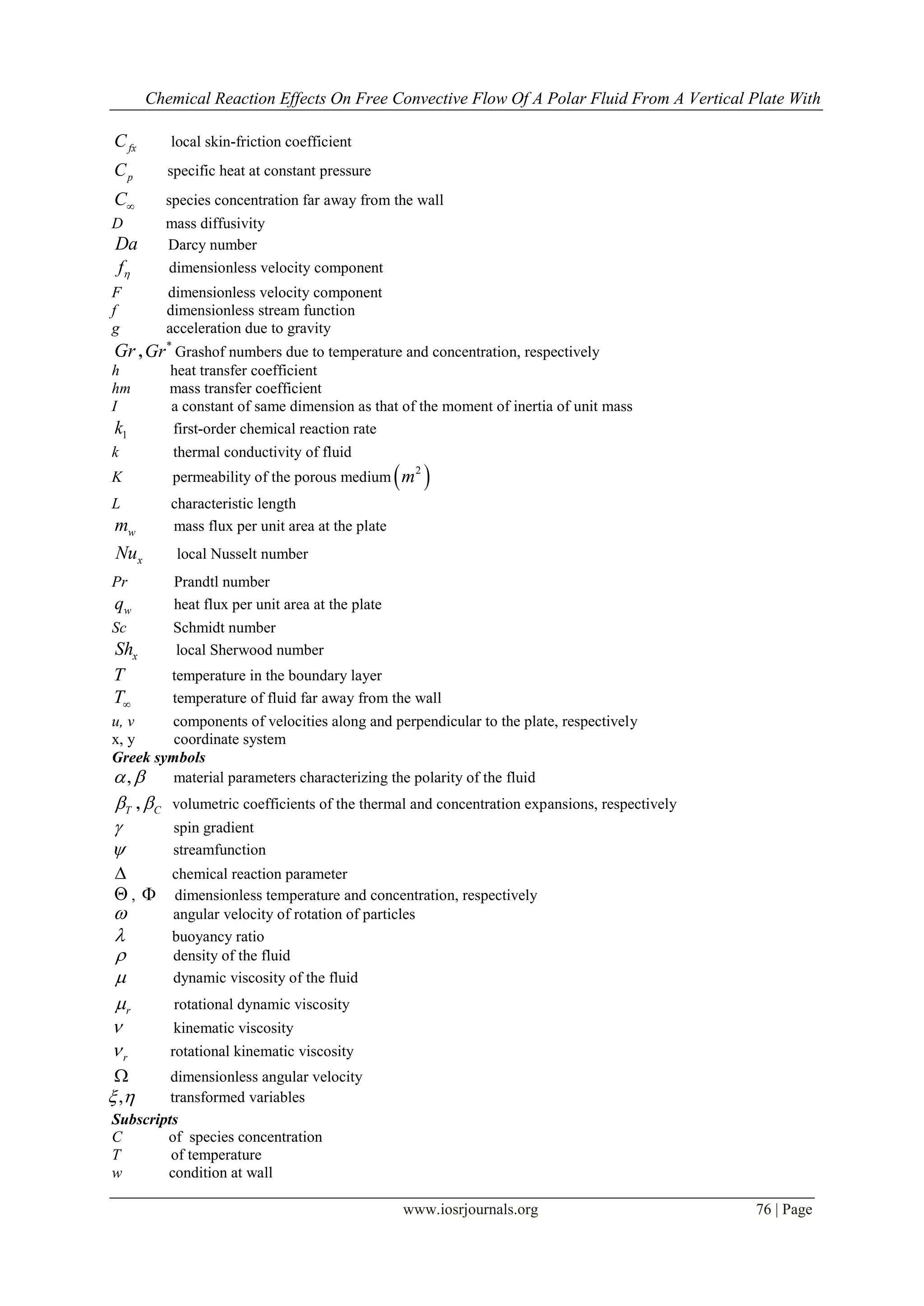
![Chemical Reaction Effects On Free Convective Flow Of A Polar Fluid From A Vertical Plate With
www.iosrjournals.org 77 | Page
free stream condition
, denote the partial derivatives w.r.t. these variables, respectively
References
[1] Cheng, P., Heat transfer in geothermal systems, Adv. Heat Transfer, 15 (1978), 1- 105.
[2] Lee, S. L., Chen, T. S., Armaly, B. F., Mixed convection along vertical cylinders and needles with uniform surface heat flux, ASME
J. Heat Transfer, 109 (1987), 711 – 716.
[3] Chen, H.T., Chen, C. K., Natural convection of non-Newtonian fluids along a vertical plate embedded in a porous medium, ASME
Journal of Heat Transfer, 110 (1988), 257 – 260.
[4] Nakayama, A., Koyama, H., Buoyancy induced flow of non-Newtonian fluids over a non-isothermal body of arbitrary shape in a
fluid saturated porous medium, Applied Scientific Research, 48 (1991), 55 – 70.
[5] Kim, G. B., Hyun, J. M., Buoyant convection of power-law fluid in an enclosure filled with heat generating porous media, Numerical
Heat Transfer, Part A: Applications. 45 (2004), 569 – 582.
[6] Rastogi, S. K., Poulikakos, D., Double diffusion from a vertical surface in a porous region saturated with a non-Newtonian fluid, Int.
J. Heat Mass Transfer, 38 (1995), 935 – 946.
[7] Jumah, R.Y., Mujumdar, A.S., Free convection heat and mass transfer of non-Newtonian power law fluids with yield stress from a
vertical plate in saturated porous media, Int. Commun. Heat and Mass Transfer, 27 (2000), 485 – 494.
[8] Jumah, R.Y., Mujumdar, A.S., Free convection heat and mass transfer from a vertical plate with variable wall temperature and
concentration to power law fluids with yield stress in a porous medium, Chemical Engineering Communications, 185 (2001), 165 –
182.
[9] Cheng, C.Y., Natural convection heat and mass transfer of non-Newtonian power law fluids with yield stress in porous media from a
vertical plate with variable heat and mass fluxes, Int. Commun. Heat and Mass Transfer, 33 (2006), 1156 – 1164.
[10] Aero, E.L., Bulygin, A.N., Kuvshinski, E.V., Asymmetric hydromechanics, J. Appl. Math. Mech, 29 (1965), 333- 346.
[11] D’ep, Nguen Van, Equations of a fluid boundary layer with couple stresses, J. Appl. Math. Mech., 32 (1968), 777 – 783.
[12] Cowin, S.C., The Theory of polar fluids, Adv. Appl. Mech., 14 (1974), 279 – 347 .
[13] Patil, P. M., Hiremath, P. S., A note on the effect of couple stresses on the flow through a porous medium, Rheol Acta, 21 (1992),
206- 207.
[14] Hiremath, P.S., Patil, P. M., Free convection effects on the oscillatory flow of a couple stress fluid through a porous medium, Acta
Mechanica, 98 (1993), 143- 158.
[15] Helmy, K. A., MHD unsteady free convection flow past a vertical porous plate, ZAMM, 78 (1998), 255 – 270.
[16] Raptis, A., Takhar, H. S., Polar fluid through a porous medium, Acta Mechanica, 135 (1999), 91-93.
[17] Kim, Y. J., Unsteady MHD convection flow of polar fluids past a vertical moving porous plate in a porous medium, Int. J. Heat Mass
Transfer, 44 (2001), 2791 – 2799.
[18] Ogulu, A., On the oscillating plate temperature flow of a polar fluid past a vertical porous plate in the presence of couple stresses and
radiation, Int. Comm. Heat Mass Transfer, 32 (2005), 1231- 1243.
[19] Patil, P. M., Kulkarni, P. S., Effects of chemical reaction on free convective flow of a polar fluid through a porous medium in the
presence of internal heat generation, Int. J. Thermal Sciences, 47 (2008), 1043 – 1054.
[20] Patil, P. M., Effects of free convection on the oscillatory flow of a polar fluid through a porous medium in presence of variable heat
flux, Journal of Engineering Physics and Thermophysics, 81(5) (2008), 905 – 922.
[21] Patil, P. M., Kulkarni, P. S., Free convective oscillatory flow of a polar fluid through a porous medium in the presence of oscillating
suction and temperature, Journal of Engineering Physics and Thermophysics, 82(6) (2009), 1138 – 1145.
[22] Chang, C. L., Lee, Z. Y., Free convection on a vertical plate with uniform and constant heat flux in a thermally stratified micropolar
fluid, Mechanics Research Communications, 35 (2008), 421 – 427.
[23] Skelland, A.H.P., Diffusion of Mass Transfer, Wiley, New York (1974).
[24] Levenspiel, O., Chemical Reaction Engineering, 3rd
Edition, Wiley, New York (1999).
[25] Fairbanks, D. F., Wilke, C.R., Diffusion and chemical reaction in an isothermal laminar flow along a soluble flat plate, Ind. Eng.
Chem. Res., 42 (1950), 471 – 475.
[26] Van Genuchten, M. Th., Analytical solution for chemical transport with simultaneous adsorption, zeroth order production and first
order decay, J. Hydrology, 49 (1981), 213 – 233.
[27] Das, U. N., Deka, R. K., Soundalgekar, V.M., Effects of mass transfer on the flow past an impulsively started infinite vertical plate
with constant heat flux and chemical reaction, Forschung im Ingenieurwes - Engineering Research, 60 (1994), 284- 287.
[28] Muthucumaraswamy, R., Ganesan, P., On impulsive motion of a vertical plate with heat flux and diffusion of chemically reactive
species, Forsch. Ingenieurwes, 66 (2000), 17- 23.
[29] Muthucumaraswamy, R., Ganesan, P., First order chemical reaction on flow past an impulsively started vertical plate with uniform
heat and mass flux, Acta Mechanica, 147 (2001), 45- 57.
[30] Seddeek, M. A., Finite element method for the effects of chemical reaction, variable viscosity, thermophoresis and heat generation /
absorption on a boundary layer hydromagnetic flow with heat and mass transfer over a heat surface, Acta Mechanica, 177 (2005), 1-
18.
[31] Kandasamy, R., Perisamy, K., Sivagnana Prabhu, K. K., Effects of chemical reaction, heat and mass transfer along a wedge with heat
source and concentration in the presence of suction or injection, Int. J. Heat Mass Transfer, 48 (2005a), 1388-1394.
[32] Kandasamy, R., Perisamy, K., Sivagnana Prabhu, K. K., Chemical reaction, heat and mass transfer on MHD flow over a vertical
stretching surface with heat source and thermal stratification effects, Int. J. Heat Mass Transfer, 48 (2005b), 4557- 4561.
[33] Raptis, A., Perdikis, C., Viscous flow over a non-linearly stretching sheet in the presence of a chemical reaction and magnetic field,
Int. J. Nonlinear Mech., 42 (2006), 527- 529.
[34] Inouye, K., Tate, A., Finite difference version quasilinearisation applied to boundary layer equations. AIAA Journal, 12 (1974), 558-
560.
[35] Patil, P. M., Roy, S., Unsteady mixed convection flow from a moving vertical plate in a parallel free stream: Influence of heat
generation or absorption, Int. J. Heat Mass Transfer, 53 (2010), 4749 – 4756.
[36] Schlichting, H., Boundary Layer Theory, Springer, New York, 2000.
[37] Varga, R. S., Matrix Iterative Analysis, Prentice Hall, 2000.](https://image.slidesharecdn.com/h0656685-150428024736-conversion-gate02/75/Chemical-Reaction-Effects-on-Free-Convective-Flow-of-a-Polar-Fluid-from-a-Vertical-Plate-with-Uniform-Heat-and-Mass-Fluxes-12-2048.jpg)
![Chemical Reaction Effects On Free Convective Flow Of A Polar Fluid From A Vertical Plate With
www.iosrjournals.org 78 | Page
Table 1. Comparison of
1/5
x xNu Gr
for selected values of Pr to previously published work with α=0, Δ=0, λ=0
and 1/Da=0.
Pr Lee et al. [2] Chang and Lee [22] Present results
0.1 0.2634 0.2634 0.263914
0.7 0.4838 0.4838 0.483776
7.0 0.8697 0.8697 0.870026
100.0 1.5546 1.5532 1.556758](https://image.slidesharecdn.com/h0656685-150428024736-conversion-gate02/75/Chemical-Reaction-Effects-on-Free-Convective-Flow-of-a-Polar-Fluid-from-a-Vertical-Plate-with-Uniform-Heat-and-Mass-Fluxes-13-2048.jpg)
